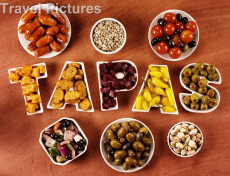
Spain is one of the most popular places to go on holiday for many British people. Lots of them don’t eat the local food whilst they’re away, but they’re really missing out. Spanish food has a lot of seafood in it, but it’s also really healthy, like the rest of the Mediterranean diet. When you think of Spanish food, you might think of paella or tapas, but dishes like this are a product of various different invasions and innovations throughout history. Next time you go to Spain, read up on Spanish history a little bit, and see if you can spot the ways in which it’s affected food in the country.
As Spain is on the other end of Europe to most of the continent’s major, ancient cities, the diet of the people varied considerably. When the Romans eventually made it to Spain, they introduced mushrooms. They also introduced grapes, and wine, partly because the Greeks had done something similar before then. After the fall of the Roman Empire, Germanic tribes like the Goths began to introduce products from colder climates, like beer.
But Spain is a little different to much of Europe. Because it’s so close to North Africa (predominantly Arabic Muslim countries), Muslims were able to cross the Mediterranean and bring over some of their own culinary traditions. You’ll see the impact Moorish people had on Spain – just visit the famous Mosque of Cordoba, a World Heritage Site. The Muslims brought with them many spices, as well as rice, and exotic fruits and vegetables. What’s a paella without rice? It’s not a paella at all!
Some time after this unique period, the Spanish hired Christopher Columbus, the man who is credited with discovering America. Don’t just think about North America though – remember that most of South America speaks Spanish, because that’s where Spanish people settled and colonised the land. As the discovery of America had hugely impacted the diet of countries in Europe, it was particularly pronounced in the case of Spain. Potatoes, peppers, tomatoes, vanilla and chocolate all reached the Spanish shores. However, they weren’t all received with a warm embrace. Cocoa, the stuff they make chocolate from, was disliked by many because it’s naturally very bitter. Go into your store cupboard and try and eat some cocoa powder. Wait – you can’t! It’s disgusting. The Spanish were the first to mix it with sugar to make it the tasty, delicious but sinful snack it is today. Thank god for that!
As with essentially everywhere around the world, different regions in Spain have different types of cooking. This all depends on the geography of the area. If it’s mountainous, as in the Pyrenees, you can expect lots of herby stews filled with vegetables. If it’s by the coast, it’s likely you’ll see a lot of fish and seafood on the menu. Spain is different to the rest of Europe, though, because it has a very large desert region.
The wonderful thing about Europe is you can drive for a very short time, and experience 2 completely different cultures. For lunch, you could be eating a baguette with camembert and a patisserie dessert to finish. Then, for dinner, who knows? It’s possible you could be enjoying a tasty paella, or omelette, or even some of the rarer Spanish delicacies.
Image from: http://www.picturescolourlibrary.co.uk/hybrid/data.svt?viewpage=picture_details_np.jsp&pclref=1917022&se=yes

0 Comment:
Be the first one to comment on this article.